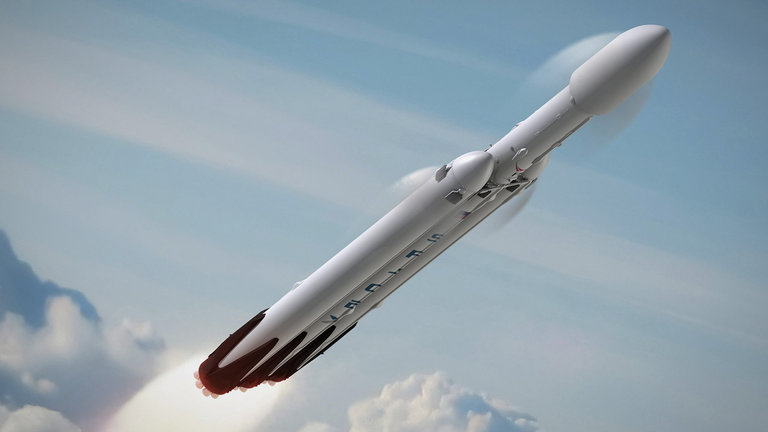Four days before Christmas in 1968, Commander Frank Borman, Command Module Pilot Jim Lovell, and Lunar Module Pilot William Anders became the first human beings ever to leave Earth and successfully complete an orbit around the moon. It was the second manned flight of the Apollo program, and its success created the basis for Neil Armstrong and Buzz Aldrin’s historic first steps on the moon the following year.
Today, almost fifty years later, only twenty-four human beings, out of billions, have ever accomplished a similar feat – and on Monday, SpaceX announced plans to add to that number for the first time since 1972, with a manned mission to orbit the moon slated for 2018.
SpaceX, one of the largest and most successful private space flight organizations in business today, has repeatedly made headlines in recent years for their re-usable rocket stages that can land under their own power after separating during launch, as well as for dramatic footage of failed rockets exploding on the launch pad. Currently, SpaceX contracts through NASA to deliver equipment and supplies to the International Space Station among other things, but in a statement released on Monday, SpaceX and its visionary founder Elon Musk, now intend to take the next step toward space tourism.
Two wealthy people who have already provided “significant deposits” will crew a SpaceX dragon capsule launched via the Falcon Heavy, a much bigger rocket than what is currently in use by SpaceX. From there, they will begin their journey around the moon – venturing further from planet Earth than any but two dozen have ever traveled before, and possibly even further.
“We expect to conduct health and fitness tests, as well as begin initial training later this year. Other flight teams have also expressed strong interest and we expect more to follow. Additional information will be released about the flight teams, contingent upon their approval and confirmation of the health and fitness test results.” The press release reads.
SpaceX doesn’t intend to launch its first manned orbital mission until the end of 2017, leaving very little time to make any changes as the Dragon capsule is refit for an extended mission that involves traveling a significantly larger distance and maintaining the crew’s life support for far longer. Unlike orbital trips that can be conducted entirely within a single day, a trip around the moon promises to take around a week.
“Back in the Apollo days the outbound journey would usually take between two and three days and the same for the return journey, maybe about a one-week round trip once they leave the Earth,” commented Jason Davis from the space advocacy group the Planetary Society.
It is a little bit different than say putting an astronaut in low-Earth orbit on the International Space Station because your quick return to Earth is no longer an option. Once you fire that rocket and head towards the Moon, you can’t turn around and go home so you are really kind of on your own for about a week with no-one to come and save you if there is a problem.” -Davis.
Elon Musk has indicated that, while the paying crew is to undergo extensive training prior to launch, the entire trip will be handled via autopilot. The two passengers will not be accompanied by a trained pilot or astronaut, at least according to statements thus far, meaning there will be no one on board to address issues that may arise.
“I would tell [the tourists] to be ready for anything as best as possible,” said Nasa astronaut Clayton Anderson. “If you get on a flight from London to Washington DC, all you need to know is how to buckle your seatbelt and how to put an oxygen mask on your face before you put it on a child; how to find the emergency exit and how to use the bathroom.”
“I hope for them it’s that simple and that safe, but it remains to be seen. I would advise them to know as much as possible about any contingency activities that could happen and what their exact roles and responsibilities would be.”
Already have an account? Sign In
Two ways to continue to read this article.
Subscribe
$1.99
every 4 weeks
- Unlimited access to all articles
- Support independent journalism
- Ad-free reading experience
Subscribe Now
Recurring Monthly. Cancel Anytime.
NASA faced the very real possibility of losing a three-man crew during its seventh moon-mission, Apollo 13. Jim Lovel, John Swigert, and Fred Haise survived thanks to their training, knowledge of the space craft and ability to work under pressure when combined with support from mission control. These space tourists, on the other hand, will have to rely on the technology they’re strapped to in order to keep them safe during the journey.
Musk claims that the crew members are well aware of the risks, but are ready to make history despite them.
“This presents an opportunity for humans to return to deep space for the first time in 45 years and they will travel faster and further into the Solar System than any before them,” the press release states.
“Designed from the beginning to carry humans, the Dragon spacecraft already has a long flight heritage. These missions will build upon that heritage, extending it to deep space mission operations, an important milestone as we work towards our ultimate goal of transporting humans to Mars.”
Image courtesy of SpaceX











COMMENTS
You must become a subscriber or login to view or post comments on this article.